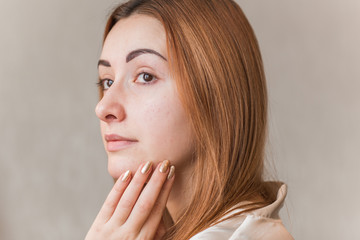

Patient Resources
Topics:
Wondering what steps to follow with skincare? Read on to find out about our recommendations. Our trained esthetician will meet with you to review your goals for healthier-appearing skin and will make suggestions based on your goals, skin type, and budget.
Chemical peels offer an innovative, in-office treatment peel followed by an at-home treatment to help with the signs of aging, including fine lines, roughness and skin discoloration.
By doing a simple skin self-exam every month, you can improve your chances of finding a melanoma early. In addition to doing routine skin self-exams, you should have your skin checked regularly by a physician.
Topical retinoids are a group of prescription medications used to reverse some of the damaging effects of sun exposure over time. These medications are also used to treat acne. The active ingredient in most preparations is tretinoin. This is now available as a generic preparation, other names are Retin-A and Renova (Renova is no longer available)
Fillers are injectable products that “fill” the void created by aging and can soften the appearance of lines. Whereas Botox is used for wrinkles in the upper one third of the face, fillers are predominantly used for the lower two thirds of the face with some exceptions. Juvederm is a filler composed of hyaluronic acid, a naturally occurring substance of the body within the skin that helps the skin retain volume.
People with intertrigo tend to have irritated red skin in the skin folds. This can occur in any place where the skin comes in contact with skin, such as the underarm area, under the breasts, and in the skin folds of the abdomen or groin.
Botox is a purified protein that temporarily blocks muscle activity leading to less lines and wrinkles on the face. Frown lines between the eyes are the most common area for Botox injections.
Here you will find a list of treatments currently being used to treat hair loss in women. The effectiveness of these agents and methods vary from person to person, but many women have found that using these treatments have made a positive difference in their hair and their self-esteem.
Alopecia areata (AA) is an autoimmune disease in which the body attacks its own hair follicles, resulting in hair loss; although the cause of alopecia areata is unknown, a person’s genetic makeup combined with other factors triggers hair loss. AA occurs worldwide, in every ethnic group and in both males and females.
Skin cancer is an uncontrolled growth of abnormal cells in the skin. Melanoma accounts for approximately 1% of all skin cancers but unfortunately accounts for the majority of skin cancer related deaths. In 2019, melanoma is expected to take the lives of 7,230 Americans.
Squamous cell carcinoma (SCC) accounts for approximately 20% of all skin cancers. It usually occurs in middle-aged and elderly people, especially those who are fair-skinned. It is more common in people who have regular prolonged sun exposure.
Basal cell carcinoma (BCC) accounts for over 75% of all skin cancers. It usually occurs in middle-aged and elderly people, especially those who are fair-skinned. It is more common in people who have regular prolonged sun exposure.
Dermatologists treat specialized areas of the skin including hair and nails. Hair loss in men and women can be associated with a variety of infections, genetic conditions, and systemic illnesses.
Rosacea causes redness in the central face and nose and is often associated with acne-like bumps. There are several different types of rosacea.
Acne occurs when hair follicles become blocked due to build-up of excess skin cells and oily secretions of the skin. The factors that contribute to this “clogging” of the pores are influenced by many factors most notably hormones involved in growth.
Psoriasis is a skin disease in which autoimmunity plays an important role. In psoriasis the immune system targets the skin and leads to inflammation which looks like red scaly patches on the body.
There are many different types of skin growths, most are “benign”, which means that they are not harmful.
Warts are rough bumps that are usually flesh-colored and tend to occur in areas of skin that are prone to trauma such as the hands, feet, elbows and knees.
Skin cancer is an extremely common condition. There are three main types of skin cancer: Basal cell carcinoma, squamous cell carcinoma and melanoma.
Examination of the skin for suspicious moles is an important means of achieving early detection for skin cancer and other conditions.
Sun exposure is proven to cause skin cancer and precancers of the skin. Find out how to protect you and your family through sunscreens, protective clothing, and wise outdoor habits.
People with eczema have very dry, sensitive skin that needs to be protected from irritation. We’ll teach you how to best care for eczema to minimize its effects on your skin.
Cryotherapy uses liquid nitrogen to treat superficial precancers, warts, and other superficial skin growths. Read about the process, care, and treatment recommendations.
Actinic Keratoses are precancers that can be treated with a cream, requiring less of a need for more painful treatments over time and leaving the skin looking and feeling healthier. Learn best practices for treatment.
After your biopsy, it’s important to follow careful instruction to keep infections away. Learn more about restricted activities and proper appearance of biopsy sites.

“There is a discernible feeling when entering Dr. Hutchin’s office that one will be well taken care of. The presence of expertise, of experience, of listening, of reassuring and of availability are there in his practice.”

























